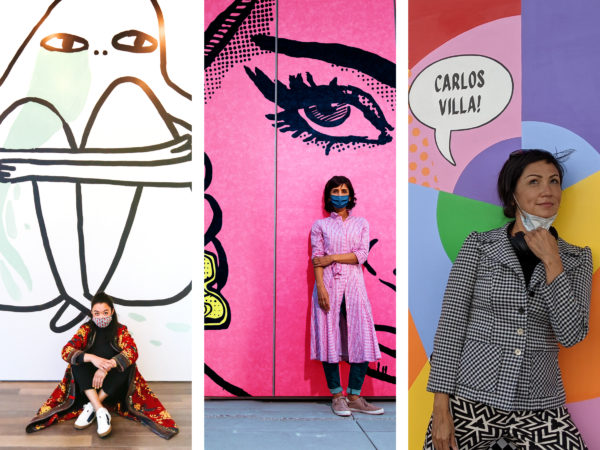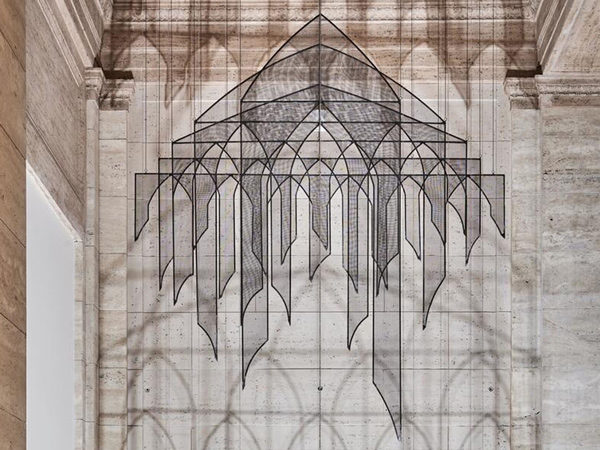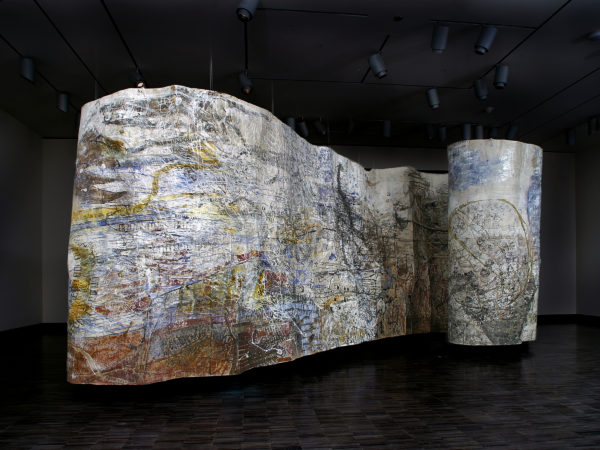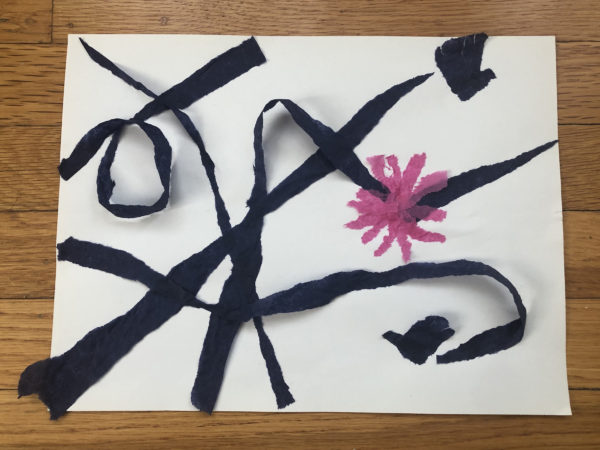Activity
The Development of Landscape Painting in China: The Song (960–1279) through the Ming (1368-1644) Dynasties
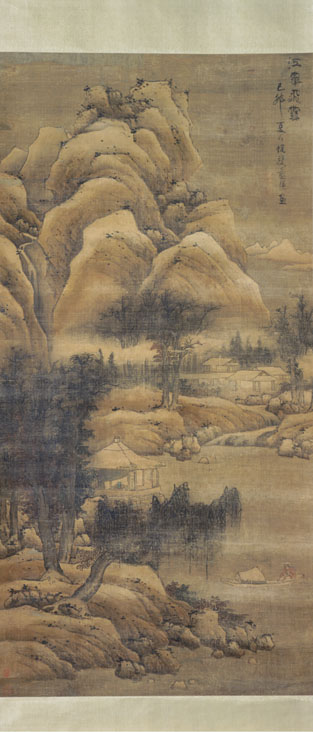
Whirling Snow on the River Bank, 1639
Chan Buddhism (Japanese: Zen Buddhism) and Painting
Developing simultaneously with the academic painting of the Southern Song (1127-1279) court, was the style of the Chan Buddhist community. This form of Buddhism (known in Japan as Zen Buddhism) centered around the practice of meditation and personal disciplines designed to bring one to sudden enlightenment, or direct apprehension of the ultimate truth.
An art of sketchy ink painting in the xieyi, or expressive style, evolved which captured the quality of sudden enlightenment sought by the practitioners. Brushstrokes were swift and spontaneous with rough textures and strong contrasts of light and dark ink. Strokes favored in the xieyi style include splashed ink, broken ink, and flying white or feibai. The Japanese imported many of these paintings along with the Chan religion to their country. They deeply appreciated and emulated the landscapes, flowers, and figures, especially those of the unorthodox patriarchs or outrageous legendary figures of the Zen tradition.
Literati Painting (wenren hua)
Literati painting (wenren hua) emerged as the cutting edge of painting styles in the following Yuan dynasty (1279-1368). After being overrun by the foreign Mongols, the scholar-gentry class distanced itself from the preceding imperial establishment as well as from the foreign invaders. Refusing to serve in the new Mongol-controlled government in Beijing, many of the leading scholars retired to the country in the south where they wrote poems, studied the classics, played the qin, and painted. Politically disgusted with the Southern Song, whom they viewed as weak and traitorous, they rejected the paintings of that period and looked back to the earlier Five Dynasties and Northern Song periods for models of complexity and rationality.
The scholar-gentleman class admired the rich vocabulary of brushstrokes found in these monumental landscapes. They collected and copied the various methods for creating texture on mountains (cun), the numerous outline patterns for suggesting different kinds of tree leaves, and the dots (dian) for distant foliage and surface texture. Each artist, in his own way, took the strokes found in calligraphy and the earlier paintings, changing them if necessary, to form his own self expressive images. They viewed painting, like calligraphy, as an extension and expression of the man, not the depiction of things or nature, although nature — and especially landscape — remained the vehicle for this expression. With some exceptions the new aesthetic favored bland, not obviously skillful, amateur painting styles. Wu Chen, one of the Four Great Masters of the Yuan, used wet, dark ink, blunt brushstrokes, and simple repetitive shapes. Critics described his paintings as “profound and remote, with a leisurely and relaxed feeling.” And the reclusive Ni Zan was know for his pale ink, dry brush, and sparse vegetation reflecting his remote and fastidious temperament. Chao Meng Fu, a leading painter and model calligrapher wrote:
A rock should look like the “flying white,”
and a tree like the “seal” stroke.
In writing the bamboo leaves,
one should first learn the pa-fen method.
If a person understands this thoroughly,
He will discover that calligraphy and
painting have always been the same.
In keeping with their literary bias, Yuan dynasty scholar-painters appropriated the use of paper, the horizontal handscroll, and the inclusion of long inscriptions on paintings. These inscriptions of old or new poems or comments by the artist added the flavor of scholarship and antiquity to the paintings, as did the formal four-character titles which were often added. Paper, which had long been used for written records and literary works, was more receptive to movement and pressure of the brush. The handscroll format allowed the creation of a long, unfolding composition which scholars could read like a book with like-minded friends. The handscroll was not a painting that would ever be hung or set out for decoration.
The Ming Dynasty (1368-1644)
During the Ming dynasty (1368-1644), the so-called professional or academic painters continued to develop parallel to, but were critically overshadowed by, the scholar-painters. Under the new emperor, the old Imperial Painting Academy was reestablished as the Zhe school in an attempt to revive the glory of China’s past. At the beginning of this dynasty, the distinction between scholar and amateur painting was not hard and fast. Artists like Qiu Ying and Lan Ying were able to cross from one style to the other and use their various talents depending on the occasion.
In the late Ming dynasty, however, the artist and critic Dong Qichang drew the firm line between professional and scholar painters, clearly favoring the latter. This had a lasting effect not only on the course of future painting but on the reputations of painters from the past as well. Dong Qichang divided Chinese painting into two categories: one group included literati painters of the Ming dynasty Wu school in southern China and the great masters of the Northern Song dynasty; Dong described the works of this category as spontaneous and intuitive. Dong called the other group the Northern School, which he characterized as being practiced, skillful, and belabored; included in this category were painters from the Zhe school. Dong’s firm stance on the status of painters embittered academic painters like Chen Hongshou, a talented painter trained first in the professional school but then not awarded the high degree of esteem that Dong granted to the less-trained scholar painters. Of Wang Wei, on the other hand, whom Dong considered to be the founder of the more respected Southern school, he wrote:
It is commonly said that the painters before [Wang Wei] were not lacking in skill, but could not transmit the spirit of a landscape…. They had not yet reached that point. Mo Ch’i [Wang Wei] started the use of wrinkles (tsun fa) and of ink washes. He started the art of expressing much by little (hsi-ching).
Underlining his point that the object of painting is not the careful recreation of visible reality, he said:
painting is no equal to mountains and water for the wonder of scenery; but mountains and water are no equal to painting for the sheer marvel of brush and ink.
[Trans. by Wai Kan Ho]
The variety of painting styles and moods became more diverse in the late Ming and Qing (1644-1911) dynasties. Professional painters of the decorative schools fade from importance as different interpretations of the orthodox, literati tradition dominate the concerns of the majority of painters and critics. Some follow closely the new orthodoxy, modelling their works on those of the Yuan and Ming scholar-painters. Reverberations of Ni Zan, Wu Chen, and Dong Qichang appear. The painters reuse and reorganize traditional texture strokes, leaf patterns, and dots in new and enlivened ways.
The Qing Dynasty (1644-1911) and Mustard Seed Garden Manual
In the Qing dynasty the Mustard Seed Garden Manual of Painting, (1679-1701), a compendium of methods of painting, grouping brushstroke techniques into categories such as trees, rocks and figures under landscapes; flowering plants and grasses; and fur and feathers was produced. This and earlier manuals made models of the styles and brushstrokes of the ancients available to a wider audience. Now, even those without access to collections of old paintings could make use of the traditional stroke vocabulary in their work. This included the Japanese, who were recipients of an influx of Chinese culture at the collapse of the Ming dynasty. A few paintings, a few artists, and the manuals of painting gave impetus to the new nanga, “Southern School,” or bunjinga, “literary man’s painting,” in Japan. Early experimenters with the style used the brushwork patterns in uniquely Japanese ways, creating flattened decorative designs only loosely related to the Chinese manner. Later artists approximated Chinese painting more closely, having had more exposure to the style and perhaps even Chinese teachers. Still the Japanese preference for flattened space and decoratively arranged forms can be detected.
In China, artists who did not follow the conservative orthodoxy still used nature in all its various forms and moods as their starting place but turned inward for their interpretation to create personally expressive styles. With the forms of nature, they produced interior images, sometimes quite fantastic; with the vocabulary of Chinese brushwork, they gave expression to their feelings and unique personalities. Daoji, one of the greatest of these masters, commented:
When asked if I paint in the manner of the Southern or the Northern School, I reply with a hearty laugh that I do not know whether I am of a school, or the school of me; I paint in my own style.
Even in the modern age, artists continue to use and interpret anew the traditional forms and brushstrokes of Chinese painting. While some modern Chinese artists adopted western models, a number of late-Qing and post-Qing artists demonstrate the continuity and adaptability of the art of Chinese brushstrokes.




